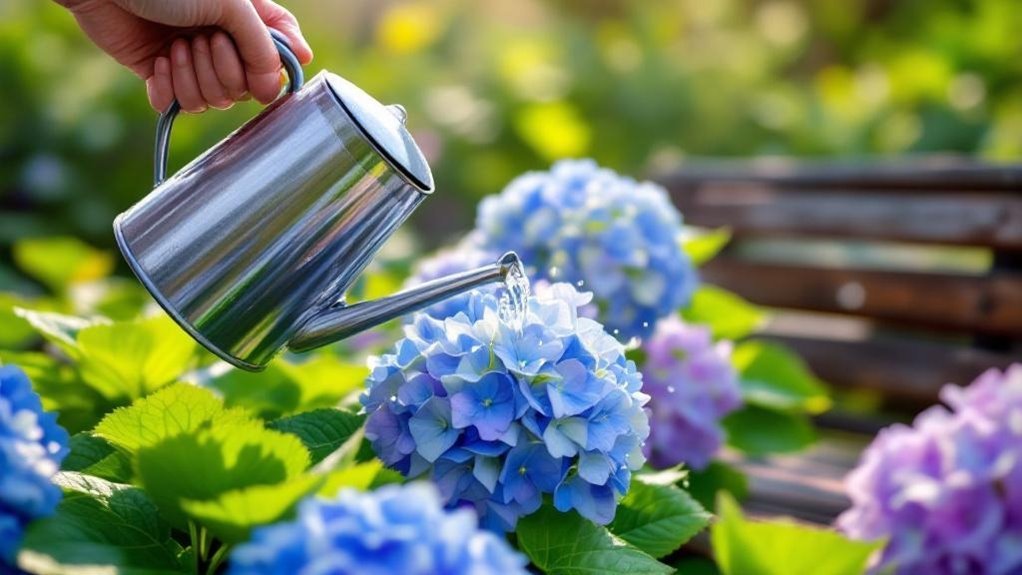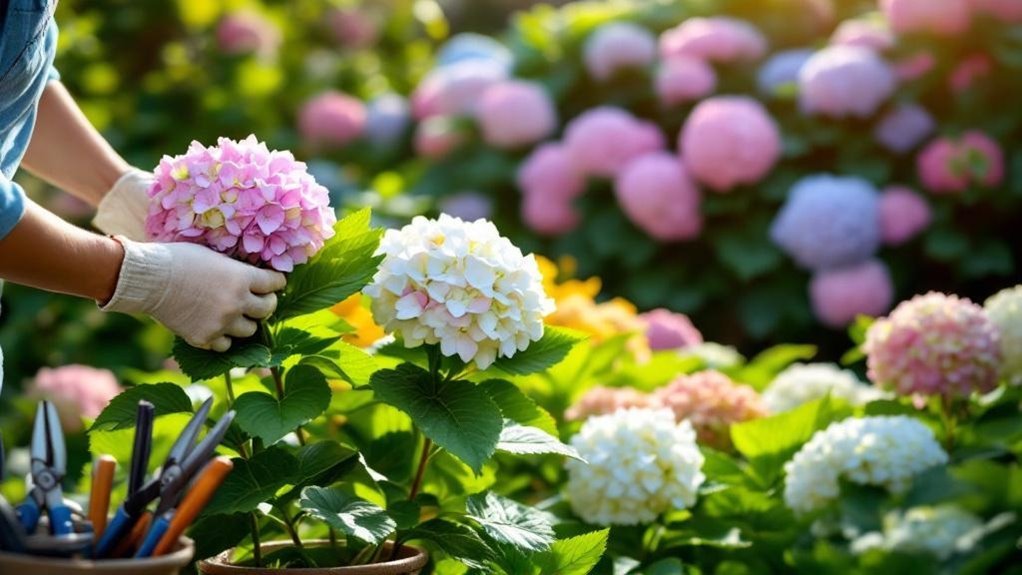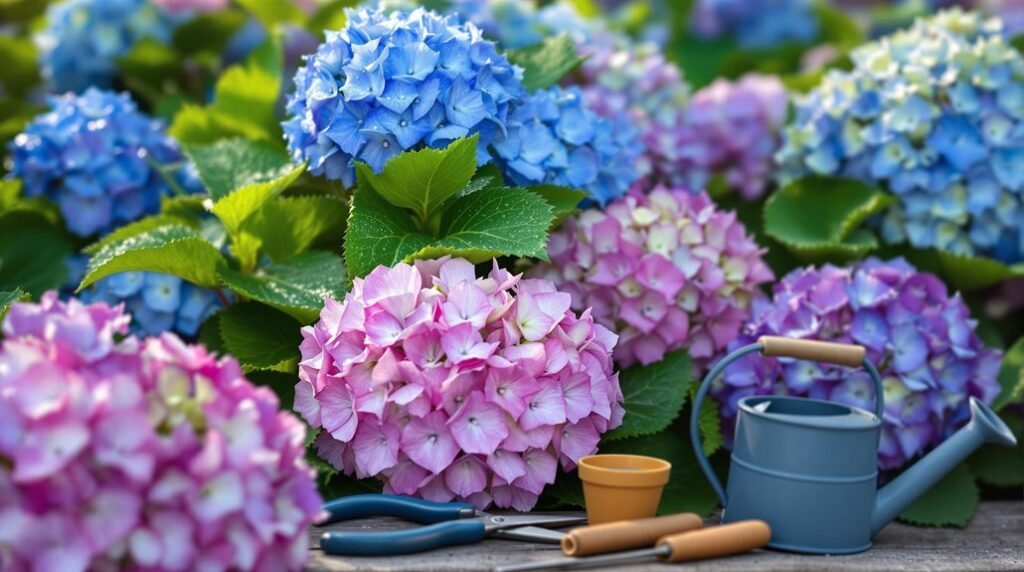Did you know that the timing of your hydrangea pruning can dramatically affect its blooms next season? Many gardeners prune at the wrong time, which can reduce flowering or even harm the plant. By adjusting your care routine with the seasons, you’ll promote healthier growth and more vibrant flowers. Understanding these seasonal maintenance tips can transform how your hydrangeas thrive throughout the year.
Best Times to Plant Hydrangeas
Although you can plant hydrangeas in either early spring or fall, timing them right helps guarantee healthy root growth and vibrant blooms.
Plant hydrangeas in early spring or fall for optimal root growth and beautiful blooms.
The best time to plant depends on your goals: early spring offers instant blooms, while fall planting promotes stronger, healthy root establishment for next season.
To reduce stress on your hydrangeas, plant during the cooler morning hours. Prepare well-drained soil enriched with organic matter to support growth.
Don’t forget to check your soil pH—acidic conditions encourage blue flowers, while alkaline soils favor pink blooms.
Light and Soil Requirements
When you provide hydrangeas with the right light and soil conditions, they’ll reward you with lush growth and vibrant blooms. Focus on light and soil requirements by planting them where they get morning sun and afternoon shade, especially in warmer climates. Use well-drained soil rich in organic matter to retain moisture without waterlogging roots. Soil preparation with compost and slow-release fertilizer encourages strong growth. Keep an eye on soil pH: acidic soil (below 6) produces blue flowers, while alkaline soil (above 7) yields pink blooms. Regular soil testing helps you adjust pH and maintain ideal conditions.
| Aspect | Recommendation | Benefit |
|---|---|---|
| Light | Morning sun, afternoon shade | Protects from heat stress |
| Soil Type | Well-drained, rich in organic matter | Retains moisture, nutrients |
| Soil pH | Acidic (blue) or alkaline (pink) | Controls flower color |
Watering Guidelines for Hydrangeas

Since hydrangeas need consistent moisture to thrive, you should water them deeply once or twice a week during the growing season, keeping the soil moist but not soggy.
Follow watering guidelines by watering deeply at the base in the morning to target roots and reduce evaporation. Check soil moisture by inserting your finger about four inches deep; if it feels dry, it’s time to water deeply again.
Applying mulch helps retain soil moisture and regulate temperature, cutting down how often you need to water. During drought conditions or hot spells, increase watering frequency to prevent stress, which you can spot from wilting leaves.
Staying attentive to soil moisture and adjusting watering keeps your hydrangeas healthy all season long.
Fertilizing Hydrangeas Seasonally
To fertilize your hydrangeas properly, apply a balanced fertilizer like 10-10-10 or 12-4-8 twice a year: once in early spring and again in mid-summer. Adding compost in spring improves soil health by enriching nutrients and enhancing moisture retention.
Avoid high-nitrogen fertilizers, as they encourage foliage over flowers. Monitor your soil health regularly, since some hydrangea varieties require less fertilization. If you want to influence bloom color, amend soil with aluminum sulfate to encourage blue blooms under acidic conditions or use lime to create pink blooms in alkaline soil.
Using a water soluble plant food like Miracle-Gro can provide a rapid nutrient absorption rate that supports vibrant blooms in a short time. These seasonal maintenance steps guarantee vibrant, healthy hydrangeas throughout the growing season.
Pruning Techniques for Different Hydrangea Types

Pruning hydrangeas correctly depends on the type you have, as each variety blooms on different wood and requires specific timing.
For Hydrangea macrophylla, prune in summer after they bloom, removing up to one-third of the stems to encourage new growth and maintain shape. Avoid pruning old wood varieties in fall since it removes buds that bloom next spring.
Hydrangea paniculata blooms on new wood, so prune it in late winter before growth starts, ensuring ideal bloom. Similarly, Hydrangea arborescens can be cut back in early spring to promote larger blooms on new wood.
When you prune, cut at a 45-degree angle just above the last green bud to encourage healthy regrowth. Proper pruning supports vigorous growth and abundant blooms season after season.
Deadheading to Encourage Reblooming
After pruning your hydrangeas to shape them and encourage growth, you can boost their blooming potential even more by deadheading spent flowers.
Deadheading involves cutting just above the first set of leaves below spent blooms, which encourages new growth and the production of new flowers. This practice, especially beneficial during the blooming season, redirects nutrients from faded blooms to developing ones, enhancing your plant’s vigor.
Varieties like Endless Summer respond well to deadheading, promoting reblooming on both old and new wood. While deadheading isn’t mandatory for plant health, it greatly improves the visual appeal and extends flowering.
Preparing Hydrangeas for Winter
As temperatures drop, you’ll want to prepare your hydrangeas for winter to protect them from harsh conditions.
Start by thoroughly watering your plants to provide adequate moisture before the ground freezes, supporting them through winter dormancy. Remove any dead or damaged stems in late fall to prevent disease and encourage healthy growth in spring.
Apply a thick layer of mulch around the base to protect roots from extreme cold and temperature fluctuations. If you have container hydrangeas, move them to a sheltered spot or wrap pots in burlap to shield roots from freezing.
Finally, gently shake off snow accumulation from branches to avoid breakage. These steps in preparing hydrangeas for winter guarantee your plants stay healthy and come back strong next season.
How to Propagate Hydrangeas Successfully
Propagation is a rewarding way to expand your hydrangea collection. To propagate hydrangeas successfully, start by taking 6-inch cuttings from healthy, non-flowering branches in early summer. Make sure each cutting has at least one node.
Dip the cut end in rooting powder to encourage root development, then plant it 2-3 inches deep in well-draining soil. Place your cuttings in a spot with indirect light to avoid stress.
Maintain a moist environment by regularly checking soil moisture, ensuring the soil stays damp but not waterlogged. Within 2-3 weeks, you should see root development, signaling successful propagation.
Managing Common Hydrangea Pests and Diseases
Once you’ve successfully propagated your hydrangeas, keeping them healthy means staying vigilant against common pests and diseases.
Watch for pests like aphids, Japanese beetles, and rose chafer beetles; use insecticidal soap or neem oil to control infestations, and hand-remove beetles when possible.
Keep an eye out for aphids and beetles; treat with insecticidal soap or neem oil and remove beetles by hand.
Powdery mildew, a fungal disease showing white patches on leaves, thrives without good air circulation—improve airflow and apply fungicides to manage it.
Bacterial leaf spot causes dark, wet spots; copper bactericides and better air circulation help control this issue.
Protect your hydrangeas from winter damage by applying a layer of mulch around the base.
Regularly inspect your plants, especially as temperatures rise in spring, to catch and treat any problems early for healthier blooms and foliage.
Adjusting Soil Ph to Change Flower Color
If you want to change your hydrangea’s flower color, adjusting the soil pH is key.
Hydrangea macrophylla, in particular, responds well to soil composition changes, allowing you to shift flower color between blue blooms and pink flowers.
Here’s how to manage it effectively:
- Lower soil pH below 6 with aluminum sulfate or sulfur for blue blooms
- Raise soil pH above 7 using lime to encourage pink flowers
- Regularly monitor pH levels with soil tests to stay on track
- Be patient, as adjusting soil pH takes time to reflect in flower color
- Note that not all hydrangeas change color; focus on Hydrangea macrophylla
Frequently Asked Questions
What Is the 1 3 Rule for Hydrangeas?
The 1-3 rule means you prune one-third of your hydrangea’s stems each year. You’ll encourage healthy growth, better air circulation, and more blooms, especially if your plant flowers on new wood. Prune at the right time!
Do Hydrangeas Need to Be Cut Back Every Year?
About 70% of hydrangeas don’t need yearly cutbacks. You shouldn’t prune every year, especially old wood types. Instead, focus on light pruning after blooming to keep your plant healthy and encourage vibrant flowers.
Should I Cut Dead Blooms off Endless Summer Hydrangea?
You should cut dead blooms off your Endless Summer hydrangea during summer. Doing this encourages new flowers, keeps your plant looking tidy, and helps it focus energy on growing strong instead of producing seeds.
How Do I Maintain My Hydrangea?
You should water your hydrangea regularly, especially when newly planted, fertilize twice yearly, prune according to its type, mulch to retain moisture, and watch for pests or diseases to keep it healthy and blooming beautifully.
Final Thoughts
So, you want perfect hydrangeas without lifting a finger? Dream on. These diva plants demand your seasonal babysitting—from spring fertilizing to winter wrapping. Miss a step, and they’ll sulk with sad blooms or stubborn colors. But hey, if you enjoy playing soil scientist, pruning pro, and watering wizard, you’re in for a treat. Follow these tips, or just let your hydrangeas fend for themselves—either way, nature’s drama unfolds!
